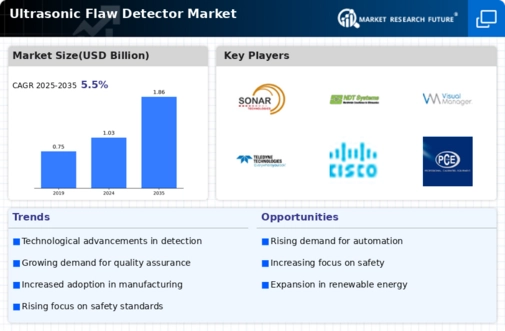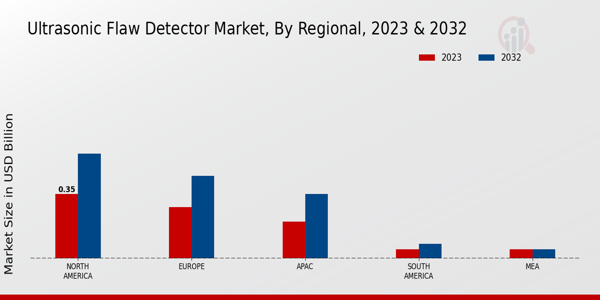Market Growth Projections
The Global Ultrasonic Flaw Detector Market Industry is projected to experience substantial growth over the next decade. With an anticipated market size of 1.03 USD Billion in 2024, the industry is expected to expand to 1.86 USD Billion by 2035, reflecting a compound annual growth rate (CAGR) of 5.5% from 2025 to 2035. This growth is indicative of the increasing reliance on ultrasonic testing across various sectors, driven by technological advancements, regulatory compliance, and a heightened focus on quality assurance.
Rising Awareness of Quality Control
Rising awareness of quality control measures is a significant factor driving the Global Ultrasonic Flaw Detector Market Industry. As industries recognize the importance of maintaining high-quality standards, the adoption of ultrasonic testing methods is becoming more prevalent. Companies are increasingly investing in ultrasonic flaw detectors to enhance their quality assurance processes, reduce waste, and improve product reliability. This heightened focus on quality control is expected to sustain market growth, with the industry evolving to meet the demands of various sectors seeking to optimize their operations.
Regulatory Compliance and Safety Standards
Regulatory compliance and safety standards are pivotal drivers for the Global Ultrasonic Flaw Detector Market Industry. Governments and regulatory bodies worldwide are enforcing stringent safety regulations across industries such as oil and gas, aerospace, and manufacturing. These regulations necessitate regular inspections and testing of materials and structures to ensure safety and reliability. Consequently, the demand for ultrasonic flaw detectors is likely to rise as companies seek to adhere to these standards. This trend is expected to contribute to the market's growth, with projections indicating an increase to 1.86 USD Billion by 2035.
Increasing Demand for Non-Destructive Testing
The Global Ultrasonic Flaw Detector Market Industry is experiencing a surge in demand for non-destructive testing (NDT) methods across various sectors, including manufacturing, aerospace, and construction. This trend is driven by the need for quality assurance and safety compliance. Industries are increasingly adopting ultrasonic testing due to its ability to detect internal flaws without damaging the material. As a result, the market is projected to reach 1.03 USD Billion in 2024, reflecting a growing recognition of the importance of NDT in maintaining structural integrity and operational efficiency.
Growing Investment in Infrastructure Development
The Global Ultrasonic Flaw Detector Market Industry is benefiting from increased investment in infrastructure development globally. Governments are allocating substantial budgets for the construction and maintenance of roads, bridges, and buildings, which necessitate rigorous testing of materials. Ultrasonic flaw detectors play a crucial role in ensuring the integrity of these structures by identifying hidden defects. As infrastructure projects expand, the demand for reliable and efficient testing methods is likely to rise, further propelling the market's growth trajectory in the coming years.
Technological Advancements in Ultrasonic Testing
Technological advancements are significantly influencing the Global Ultrasonic Flaw Detector Market Industry. Innovations such as portable ultrasonic devices, automated testing systems, and advanced signal processing techniques enhance the accuracy and efficiency of flaw detection. These advancements enable industries to perform real-time inspections, reducing downtime and improving productivity. As companies increasingly invest in state-of-the-art ultrasonic equipment, the market is expected to grow at a compound annual growth rate (CAGR) of 5.5% from 2025 to 2035, indicating a robust future for ultrasonic testing technologies.





















